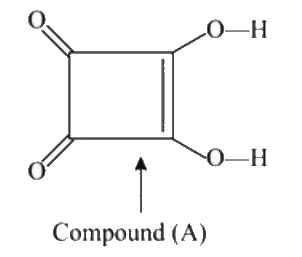Consider the following statements ,
I. In coordination compounds , metals show two types of linkage ( valencies ) .
II. The primary valencies are normallt ionisable and are satisfied by negative ions.
the correct statement(s) is / are
only I
only II
both I and II
neither I nor II
The correct Answer is:C
To analyze the given statements regarding coordination compounds, let's break down the information step by step.
Step 1: Understanding the Statements
- Statement I: In coordination compounds, metals show two types of linkage (valencies).
- Statement II: The primary valencies are normally ionizable and are satisfied by negative ions.
Step 2: Evaluating Statement I
- According to Werner's theory, coordination compounds indeed have two types of valencies: primary and secondary.
- Primary Valency: This is related to the oxidation state of the metal and is satisfied by negative ions.
- Secondary Valency: This relates to the coordination number of the metal and is satisfied by neutral or negative ligands.
- Conclusion for Statement I: This statement is correct.
Step 3: Evaluating Statement II
- The primary valencies are indeed ionizable, meaning they can dissociate in solution.
- They are satisfied by negative ions (anions) that balance the positive charge of the metal.
- Conclusion for Statement II: This statement is also correct.
Final Conclusion
Both statements I and II are correct.
Summary of the Solution
- Statement I: Correct (Two types of valencies exist in coordination compounds).
- Statement II: Correct (Primary valencies are ionizable and satisfied by negative ions).
- Statement I: In coordination compounds, metals show two types of linkage (valencies).
- Statement II: The primary valencies are normally ionizable and are satisfied by negative ions.
- According to Werner's theory, coordination compounds indeed have two types of valencies: primary and secondary.
- Primary Valency: This is related to the oxidation state of the metal and is satisfied by negative ions.
- Secondary Valency: This relates to the coordination number of the metal and is satisfied by neutral or negative ligands.
- Conclusion for Statement I: This statement is correct.
- The primary valencies are indeed ionizable, meaning they can dissociate in solution.
- They are satisfied by negative ions (anions) that balance the positive charge of the metal.
- Conclusion for Statement II: This statement is also correct.
Both statements I and II are correct.
- Statement I: Correct (Two types of valencies exist in coordination compounds).
- Statement II: Correct (Primary valencies are ionizable and satisfied by negative ions).
Topper's Solved these Questions
- BOOK - MHTCET PREVIOUS YEAR PAPERS AND PRACTICE PAPERSCHAPTER - COORDINATION COMPOUNDSEXERCISE - MHT CET Corner7videos
COORDINATION COMPOUNDS
- BOOK - MHTCET PREVIOUS YEAR PAPERS AND PRACTICE PAPERSCHAPTER - COORDINATION COMPOUNDSEXERCISE - Exercise 185videos
COORDINATION COMPOUNDS
- BOOK - MHTCET PREVIOUS YEAR PAPERS AND PRACTICE PAPERSCHAPTER - CHEMISTRY IN EVERYDAY LIFE EXERCISE - MHT CET CORNER11videos
CHEMISTRY IN EVERYDAY LIFE
- BOOK - MHTCET PREVIOUS YEAR PAPERS AND PRACTICE PAPERSCHAPTER - D - AND F-BLOCK ELEMENTSEXERCISE - MHT CET Corner27videos
D - AND F-BLOCK ELEMENTS
Similar Questions
Knowledge Check
- Question 1 - Select One
Which of the following are not postulates of Werner?
(P) In co-ordination compounds, metals show two types of linkage (valencies) primary and secondary
(Q) The primary valencies are normally ionisable. These are satisfied by negative ions.
(R) The secondary valency is equal to the co-ordination number and is fixed for a metal
(S) The ions/groups bound by the primary and secondary linkages to the metal have characteristic spatial arrangements corresponding to different coordination numbers
(T) Octahedral, Tetrahedral and Square planar geometrical shapes are more common in co-ordination compounds of transition metalsA(P), (Q), (R ) and (S)B(S) and (T)C(S)D(P), (Q), and (R ) - Question 2 - Select One
Which of the following are not postulates of Werner?
(P) In co-ordination compounds, metals show two types of linkage (valencies) primary and secondary
(Q) The primary valencies are normally ionisable. These are satisfied by netural molecules or negative ions. The secondary valency is equal to the co-ordination number and is fixed for a metal
The ions/groups bound by the primary and secondary linkages to the metal have characteristic spatial arrangements corresponding to different coordination numbers
(T) Octahedral, Tetrahedral and Square planar geometrical shapes are more common in co-ordination compounds of transition metalsA(P), (Q), (R ) and (S)B(S) and (T)C(S)D(P), (Q), and (R ) - Question 3 - Select One or More
Consider the compounds
Pick up the correct statement/s
 AII is more basic than I and IIIBAll are aromatic basesCIII is more basic than IIDI is more basic than II.
AII is more basic than I and IIIBAll are aromatic basesCIII is more basic than IIDI is more basic than II.
The primary valency of the metal ion is satisfied by
View SolutionConsider the following statements, while naming a coordination compound
I. The central metal atom is listed first.
II. The ligands are than listed in alphabetical order.
III.The placement of a ligand in the list does not depend on its charge.
The correct statement(s) is /areView SolutionConsider the following satements for Werner's theory :
(P) Ligands are connected to the metal ions by ionic bonds
Secondary valencies have directional properties
Secondary valencies are non-ionisable of these statements :View SolutionConsider the following satements for Werner's theory :
(P) Ligands are connected to the metal ions by ionic bonds
Secondary valencies have directional properties
Secondary valencies are non-ionisable of these statements :View SolutionConsider the following statements
I. ϕ∈{ϕ} II. {ϕ}⊆ϕ Which of the statements given above is/are Correct?View Solution


